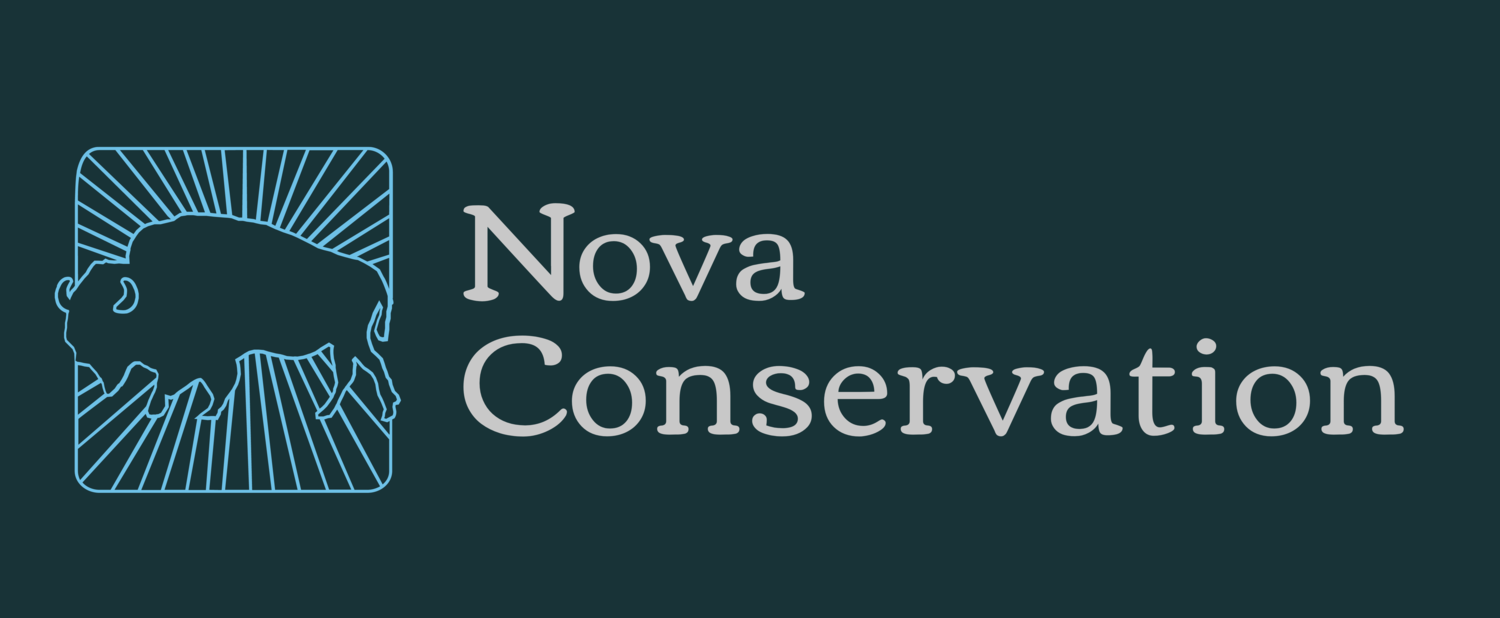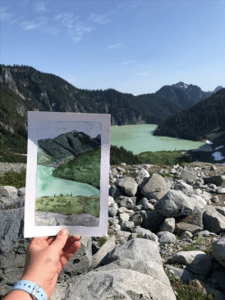Communicating Science Through Art: Interview With Jill Pelto
“I have both a privilege and a responsibility to help to promote positive environmental action and education.” – Jill Pelto
Meet Jill Pelto, a climate change artist who merges scientific research and data into her gorgeous watercolor paintings. Right there in the field, Jill will sit down with her watercolor set and express visually what science and numbers and graphs can’t communicate on their own.
Just a few months ago, TIME magazine featured Jill’s artwork titled Currents. The piece depicts climate change data- everything from CO2 emissions changes (1882 – present) to average global temperature changes (1880 – present). Jill’s work has been in Smithsonian, PBS NewsHour, and National Geographic, and is also being used in K-12 curriculum programs across the U.S. and Canada. I was lucky enough to have the opportunity to speak with Jill about her work, her hopes for the future of the planet, and words of advice to all those out there wishing to make their own (green) mark on the world.
What sparked your interest in taking science data and turning it into art?
As a college student, I did a double major in Earth and Climate Science and Studio Art. I always saw connections in these two fields and was struggling to communicate the things I learned about in the sciences with my peers in art. The idea of using science data began when I began working with my dad, Mauri Pelto, on the North Cascade Glacier Climate Project. Every August we measure a group of mountain glaciers in the North Cascade Range in Washington to quantify how much they change. In 2015, the effects of severe drought and forest fires had caused such dramatic loss to the glaciers and affected the whole ecosystem drastically. When I returned to school in Maine, I wanted to communicate what I’d seen. That’s when I realized I could use data about those changes to tell the story directly!
Could you take me through your professional life and the different roles you have played throughout your career?
I am 27. I finished my Masters of Science 2 years ago in the summer of 2018. Before and during that time I had been developing my art career, and my goal since then has been to pursue a full-time career in Art/Science Communication. When I describe to people what I do, I label myself a Climate Change Artist. Right now that can’t sustain me on its own, so I have worked other part-time jobs to fill in the gaps. I would love to find a part-time science communication/outreach position within the next year and use the rest of my time to continue to create new science art!
Why do you think your work is important, especially to conservation?
Good question! I got into this work because I was passionate about communicating environmental stories that I saw as important, and particularly topics surrounding climate change. I have learned a lot about the communication field since I began. The arts play a huge part in cultural communication. Environmental art has grown from a niche field to something that people are taking notice of. Take the work of pastel artist Zaria Forman for example. Art has a certain power to capture people with emotion- something that is difficult for science on its own to achieve. So connecting science with writing, sculpture, video, etc. just helps more people to learn about topics like climate change, and to have it connect with them on a deeper level.
How do you pick your art projects? Is it inspired by travel or particular regions?
A mix. Some projects are science research I’ve been a part of, some are projects I’ve learned about directly from research teams, and some are just topics I’ve looked into independently and have been inspired to communicate. There are so many topics I’d love to make art about, and while personal connections can drive me, I also want to make work about things I’m not yet familiar with, and places and people who face other environmental changes than those I do.
What is the best place you’ve traveled to, either for work or vacation?
I’m fortunate in saying that is a difficult question! I think my absolute favorite place is the North Cascade range in Washington state. I’m in awe of the direct connection of the glaciers with the water resources they supply, and the ecosystems they create. You have steep alpine meadows covered in wildflowers next to stark crevassed rivers of ice.
The most unique place I traveled was for my Master’s research. I worked in the mountain range that spans across Antarctica (the Transantarctic Mountains). It is a vast landscape, nearly devoid of life and of color. It is stunning and harsh there. I treasure getting to see those corners of the world that few will. While I was there I would paint landscapes, and I’m so inspired by the simple striking palette and complex patterns of the landscape there.
What’s the most unique animal/phenomenon/etc you’ve seen in the field?
It’s truly the most pleasurable experience when you can observe wildlife without disturbing it, and really just watch as animals do their thing. I really love watching mountain goat herds in the North Cascades. The herds I’ve watched are very wild and unaccustomed to humans, so they stay away from you. I love watching the babies play on steep snow slopes, and seeing the whole herd climbing cliffs just to get around in the mountains. I also love when we find a really beautiful glacier cave. It doesn’t happen often, and we are careful about which ones we go in. But it is so stunning to see the bottom of the glacier, and look up at the old ice in such bizarre, beautiful forms and colors.
What’s a funny field story you want to share?
Ravens are really clever! One spot we worked at in the North Cascades is a large volcano called Mt. Baker. We camp near one of the popular climbing routes to get to the summit, and the ravens that live there have learned human habits. They know that people cache (store) food. We build a cairn (pile of rocks) to hide our food in so that they can’t get at it when we’re working the glacier above during the day. One year they were spiteful about this and each day they would take off the cover of my brother’s backpack at camp, unzip all the pockets, and throw things out. There was no food there, and for some reason they only targeted him!
If you could give one piece of advice to the younger generation wishing to pursue a path in science, what would it be?
There are so many paths to take in science! I am most familiar with the natural sciences: environmental, wildlife/ecology, marine, earth, climate, glaciers. Feel free to explore and learn about these fields a bit before deciding what path you want to go on. And when you do, seek opportunities in and out of school that can connect you with hands-on work in the lab or in the field. Pursue the topics that you really enjoy learning about, and ones you’d like to contribute to in the future. Think about if you want to study the past, present, or future of the natural world. And remember that interdisciplinary connections are so important these days! Engaging on social media, connecting with writing or the arts, thinking about the social sciences, etc.
If you could give one piece of advice to the younger generation wishing to pursue a path in science, what would it be?
There are so many paths to take in science! I am most familiar with the natural sciences: environmental, wildlife/ecology, marine, earth, climate, glaciers. Feel free to explore and learn about these fields a bit before deciding what path you want to go on. And when you do, seek opportunities in and out of school that can connect you with hands-on work in the lab or in the field. Pursue the topics that you really enjoy learning about, and ones you’d like to contribute to in the future. Think about if you want to study the past, present, or future of the natural world. And remember that interdisciplinary connections are so important these days! Engaging on social media, connecting with writing or the arts, thinking about the social sciences, etc.
You inspire many people across the nation to explore and experience the natural world. What continues to inspire you throughout your journey?
The same love for the outdoors I’ve always had. I truly love being out in nature and also creating art. I have both a privilege and a responsibility to help to promote positive environmental action and education. There has been more momentum and more change in that area in recent years, and I see a lot of that coming as my generation and the generation behind me begin to join the conversation. Many in my parents’ generation and beyond fought really hard to communicate climate change, and finally, so many people are listening and taking action. Many of the schools I visit now discuss and teach about climate change, and the student’s genuinely care. This gives me so much hope.
Do you want to follow along with Jill Pelto? You can find her here:
Twitter: @GlaciogenicArt
Instagram: @jillpelto
Website: http://www.jillpelto.com/
Thank you for sharing your story with us Jill!
All photos featured in this article are credited to Jill Pelto.
If you enjoyed this article, you can check out other interviews that we have to offer on our blog. Nova Conservation is passionate about supporting diverse voices in life science careers.
If you are interested in an interview, please contact us here.







